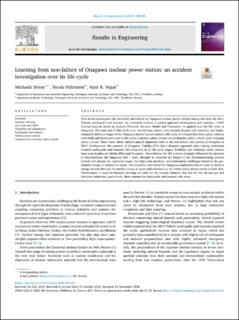| dc.contributor.author | Ibrion, Mihaela | |
| dc.contributor.author | Paltrinieri, Nicola | |
| dc.contributor.author | Rasekhi Nejad, Amir | |
| dc.date.accessioned | 2021-02-19T09:16:40Z | |
| dc.date.available | 2021-02-19T09:16:40Z | |
| dc.date.created | 2020-12-10T15:30:45Z | |
| dc.date.issued | 2020 | |
| dc.identifier.citation | Results in Engineering (RINENG). 2020, 8 . | en_US |
| dc.identifier.issn | 2590-1230 | |
| dc.identifier.uri | https://hdl.handle.net/11250/2729099 | |
| dc.description.abstract | This article investigates the successful survival of the Onagawa nuclear power station during and after the 2011 Tohoku earthquake and tsunami. As a research method, a system approach investigation and analysis— CAST (Causal Analysis based on Systems Theoretic Accident Model and Processes)—is applied over the life cycle of Onagawa. The main aim of this study is to identify how seismic and tsunami disaster risk reduction was implemented in different stages of the Onagawa nuclear power station’s life cycle. It is found that three safety cultures were built and developed over its life cycle: a nuclear safety culture, an earthquake safety culture, and a tsunami safety culture. These three safety cultures played important roles in the non-failure and success of Onagawa in 2011. Furthermore, the operator of Onagawa, Tohoku EPCo has a dynamic approach and a strong leadership towards earthquake and tsunami risk mitigation in all life cycle stages; flexibility and voluntary safety actions have been in place at Tohoku EPCo and Onagawa . Nevertheless, the 2011 events strongly influenced the decision to decommission the Onagawa Unit 1 early, brought to attention the length of the decommissioning process (which will surpass the operation stage), the high costs involved, and tremendous challenges linked to the permanent storage of radioactive waste. The successful survival of the Onagawa emphasizes that in order to achieve energy security through the nuclear energy in Japan and elsewhere in the world, safety always needs to come first. Furthermore, it supports dynamic learning not only for the nuclear industry, but also for the oil and gas and maritime industries; particularly, those situated in earthquake and tsunami risk areas. | en_US |
| dc.language.iso | eng | en_US |
| dc.publisher | Elsevier | en_US |
| dc.rights | Navngivelse 4.0 Internasjonal | * |
| dc.rights.uri | http://creativecommons.org/licenses/by/4.0/deed.no | * |
| dc.title | Learning from non-failure of Onagawa nuclear power station: an accident investigation over its life cycle | en_US |
| dc.type | Peer reviewed | en_US |
| dc.type | Journal article | en_US |
| dc.description.version | publishedVersion | en_US |
| dc.source.pagenumber | 20 | en_US |
| dc.source.volume | 8 | en_US |
| dc.source.journal | Results in Engineering (RINENG) | en_US |
| dc.identifier.doi | 10.1016/j.rineng.2020.100185 | |
| dc.identifier.cristin | 1858396 | |
| dc.description.localcode | This is an open access article distributed under the terms of the Creative Commons CC-BY license, which permits unrestricted use, distribution, and reproduction in any medium, provided the original work is properly cited. | en_US |
| dc.source.articlenumber | 100185 | en_US |
| cristin.ispublished | true | |
| cristin.fulltext | original | |
| cristin.qualitycode | 1 | |

